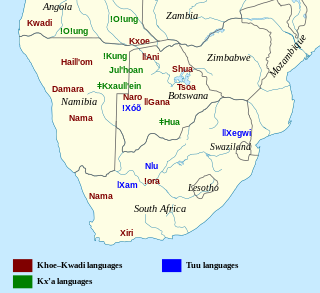
Back لغة تا Arabic Llengua !Xóõ Catalan Taa-Sprache German Taa lingvo Esperanto Idioma ǃxóõ Spanish Hoo keel (khoisani) Estonian ǃXóõ Finnish ǃXóõ French !Xóõ Irish Lingua taa Galician
| Taa | |
|---|---|
| ǃKhong, ǃXóõ | |
| Taa ǂaan / Tâa ǂâã (ǃXóõ) | |
| Native to | Botswana, Namibia |
| Region | Southern Ghanzi, northern Kgalagadi, western Southern and western Kweneng districts in Botswana; southern Omaheke and northeastern Hardap regions in Namibia. |
Native speakers | 2,500 (2011)[1] |
Tuu
| |
| Dialects |
|
| Language codes | |
| ISO 639-3 | nmn |
| Glottolog | taaa1242 |
| ELP | Taa |
 | |
Taa /ˈtɑː/ TAH, also known as ǃXóõ /ˈkoʊ/[2] KOH (also spelled ǃKhong and ǃXoon; Taa pronunciation: [ǃ͡χɔ̃ː˦]),[3] is a Tuu language notable for its large number of phonemes, perhaps the largest in the world.[4] It is also notable for having perhaps the heaviest functional load of click consonants, with one count finding that 82% of basic vocabulary items started with a click.[5] Most speakers live in Botswana, but a few hundred live in Namibia. The people call themselves ǃXoon (pl. ǃXooŋake) or ʼNǀohan (pl. Nǀumde), depending on the dialect they speak. The Tuu languages are one of the three traditional language families that make up the Khoisan languages. In 2011, there were around 2,500 speakers of Taa.
Taa is the word for 'human being'; the local name of the language is Taa ǂaan (Tâa ǂâã), from ǂaan 'language'. ǃXoon (ǃXóõ) is an ethnonym used at opposite ends of the Taa-speaking area, but not by Taa speakers in between.[6] Most living Taa speakers are ethnic ǃXoon (plural ǃXooŋake) or 'Nǀohan (plural Nǀumde).[7]
Taa shares a number of characteristic features with West ǂʼAmkoe and Gǀui, which together are considered part of the Kalahari Basin sprachbund.[8]
- ^ Taa at Ethnologue (19th ed., 2016)

- ^ Alan Barnard (…) Hunters and Herders of Southern Africa, p.xxii.
- ^ The Taa pronunciation of "ǃXóõ" can be heard in this recording, repeated from 0′16″ to 0′24″.
- ^ Rousseau, Bryant (25 November 2016). "Click languages". The New York Times. Retrieved November 11, 2022.
- ^ See Sands & Gunnink (2019) "Clicks on the fringes of the Kalahari Basin Area." In Clem et al. (eds), Theory and Description in African Linguistics: Selected Papers from the 47th Annual Conference on African Linguistics. Language Science Press, Berlin, pp. 703–724.
- ^ Gertrud Boden, 2007, ǃQamtee ǀaa ǂXanya: 'the Book of Traditions' : Histories, Texts and Illustrations from the ǃXoon and 'Nǀohan People of Namibia
- ^ DoBeS, "Taa".
- ^ Güldemann, Tom; Fehn, Anne-Maria (2015). "The Kalahari Basin area as a "Sprachbund" before the Bantu expansion - an update". Instituts für Asien- und Afrikawissenschaften der Humboldt-Universität zu Berlin. Archived from the original on 2015-09-28. Retrieved 2016-04-05.
© MMXXIII Rich X Search. We shall prevail. All rights reserved. Rich X Search